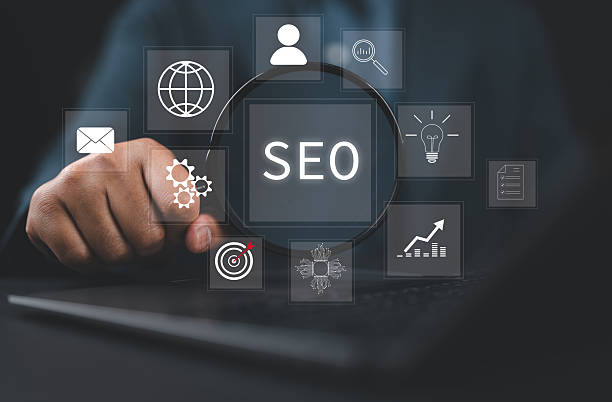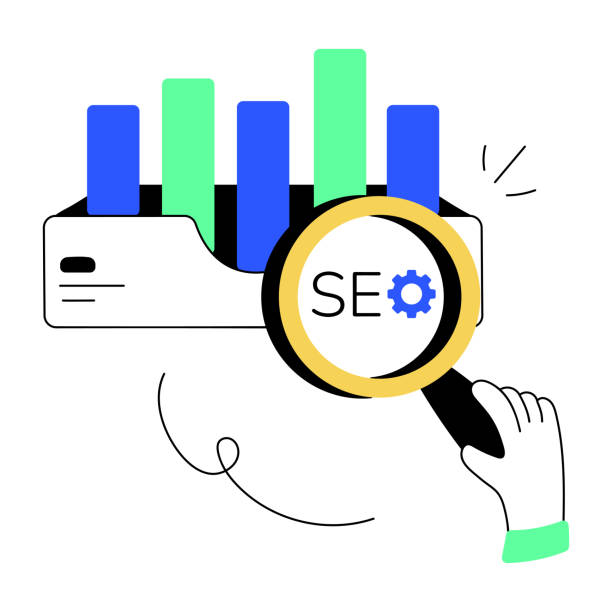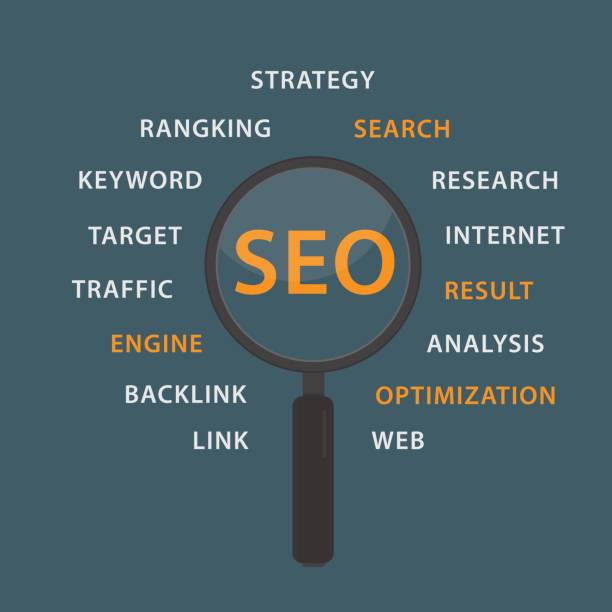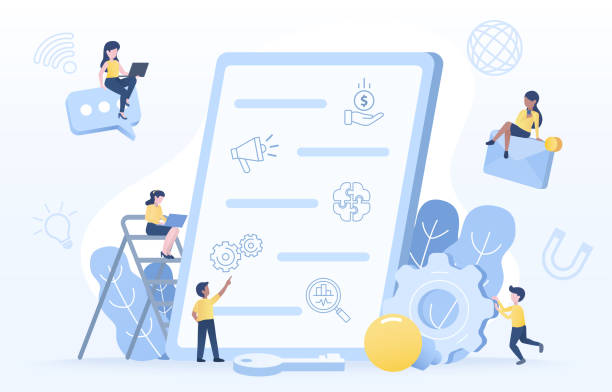An Introduction to Powerful and Vital Internal SEO

In today’s highly competitive internet world, a successful online presence is almost impossible without paying attention to the principles of search engine optimization, or SEO.
Among these, the vital and foundational part of this process is internal SEO, which refers to a set of actions performed within your website to improve its ranking in search engine results.
These actions include optimizing content, site structure, HTML codes, and other technical factors.
Many experts believe that without strong internal SEO, your efforts in other SEO areas, such as off-page SEO, no matter how extensive, will not yield the desired results.
This area of SEO is instructive and complex, but a proper understanding of it can make a big difference in your site’s traffic and success.
This section is the foundation of any successful digital marketing strategy.
An optimized internal SEO helps search engines better understand your content, and consequently, display it to more relevant users.
This not only increases traffic but also improves the quality of incoming traffic.
In the continuation of this article, we will professionally and in full detail explore various aspects of internal site optimization to guide you on the path to mastering this important art.
Get ready to turn your site into a visitor magnet.
Did you know that a weak corporate website costs you many opportunities daily? Solve this problem forever with professional corporate website design by Rasawab!
✅ Create a powerful and trustworthy brand image for your brand
✅ Targeted attraction of new customers and increased sales
⚡ [Get Free Website Design Consultation]
Key Elements of Internal SEO and the Role of Keywords

One of the main and fundamental pillars in internal SEO strategy is the research and selection of appropriate keywords.
Keywords are phrases that users enter into search engines to find the content they are looking for.
Choosing the right keywords is the first step to attracting your target audience.
This process must be analytical and precise, including an examination of search volume, competition level, and the keyword’s relevance to your content.
Once selected, these keywords should be strategically placed in various parts of the page, including the Title Tag, Meta Description, H1 to H6 headings, the main content text, and even the page URL.
Intelligent use of keywords signals to search engines what topic your content is related to.
Meta descriptions, although not directly impacting ranking, play an important role in attracting user clicks from the search results page, as they are the first impression a user gets of your content.
Successful internal SEO requires a balance between optimization for search engines and user experience (UX).
Therefore, you should never force keywords into the text (Keyword Stuffing), as this not only harms your ranking but also disrupts the user experience.
Our approach should be guiding and natural, so that the content remains fluid and readable.
Optimizing these elements is the foundation of any successful internal SEO strategy that correctly helps search engines and users find and understand your website.
Content and Structure Optimization for Internal SEO

Quality content and appropriate structure are the heart of internal SEO.
Search engines aim to provide their users with the most relevant and highest-quality content, so your content must not only offer comprehensive and accurate information but also be structured in a way that is easily understandable for both users and search engine crawlers.
Using heading tags (H1, H2, H3, etc.) is essential for segmenting text and creating a semantic hierarchy.
H1 should include the main keyword and be used only once per page, while H2 and H3 can be used for subheadings and subtopics.
Question-provoking content can engage users more and increase their time spent on the site.
Additionally, the use of lists (both numbered and bulleted), short paragraphs, and clear sentences significantly improves readability.
This explanatory and practical approach helps users quickly access the information they need.
Adhering to these principles in content design not only improves user experience but also helps search engines better understand your page’s structure and main topic.
Remember that the main goal of internal SEO is to create content that is both optimized for search engines and valuable and engaging for users.
Below, the table shows examples of structural content optimization:
| Structural Element | Correct Example for Internal SEO | Incorrect Example (Anti-SEO) |
|---|---|---|
| H1 Tag | <h1>Complete Guide to Internal SEO in 2024</h1> | <h1>Hello!</h1> or multiple H1s |
| Keyword Usage | Natural repetition of keywords in text | Excessive repetition (Keyword Stuffing) |
| Paragraphs | Short and concise (2-4 sentences) | Long paragraphs without breaks |
| Internal Links | Link to relevant content with appropriate anchor text | Link to irrelevant pages or without anchor text |
Technical Aspects of Internal SEO for Speed and User Experience

Internal SEO is not limited to content; the technical aspects of a website also play a very important role in its ranking.
Page load speed is one of the most important ranking factors that directly affects user experience (UX).
Today’s users are impatient, and a slow website quickly drives them away, leading to an increased bounce rate and decreased time on site.
Optimizing images (compression and use of modern formats), reducing the size of CSS and JavaScript files, using browser caching, and choosing a powerful hosting provider are among the actions that help increase site speed.
The analytical and technical nature of these actions requires specific knowledge and tools.
In addition to speed, mobile-friendliness is also a crucial factor, as a large portion of searches today are performed via mobile devices.
Google ranks websites that are not mobile-optimized lower.
Clear and logical site architecture, the use of HTTPS protocol for security, and an XML sitemap to help search engines crawl and index pages are other important technical considerations in internal SEO.
All these technical factors are interdependent, and optimizing each of them individually or in combination can have a significant impact on your website’s overall performance in search results.
This specialized part of internal SEO is a foundation for visibility and success in the online space.
Is your online sales not as you expect? With Rasawab, solve the problem of low sales and poor user experience forever!
✅ Increase visitor to customer conversion rate
✅ Create a pleasant user experience and increase customer trust
⚡ Act now to get free consultation!
Content-Driven Strategy in Internal SEO

One of the key approaches to optimizing internal SEO is developing a comprehensive and targeted content strategy.
Your content should not only include relevant keywords but also address user needs and fully inform them about a specific topic.
The E-A-T (Expertise, Authoritativeness, Trustworthiness) principle, emphasized by Google, highlights the importance of providing expert, authoritative, and trustworthy content.
This means your content should be produced by experts or by citing reliable sources.
Understanding user intent in search is also very important.
Is the user looking for information (informational search), intending to buy (transactional search), or looking for a specific website (navigational search)? Your content must align with these intents.
Producing long-form content that addresses all aspects of a topic can increase your credibility in that area and provide a chance to rank for a variety of keywords.
This approach not only helps search engines understand the value of your content but also improves user experience, as users find all the information they need in one place.
A strong content strategy built on user needs and internal SEO principles can drive significant organic traffic to your website and turn it into an authoritative resource in its field.
This part of internal SEO is completely guiding and fundamental, and without it, significant progress will not be achieved.
Optimizing Images and Internal Links in Internal SEO

Alongside textual content, optimizing images and correctly using internal links are also vital aspects of internal SEO.
Images constitute an important part of your website’s user and visual experience, but if not properly optimized, they can significantly reduce page load speed.
To optimize images, you should use appropriate formats (such as WebP), compress their size, and adjust their dimensions to suit the page’s needs.
Additionally, using Alt tags (alternative text) for images not only helps visually impaired individuals but also allows search engines to understand the image content, thereby improving your ranking for image searches.
This section of internal SEO is very instructive and practical.
On the other hand, Internal Links refer to links that connect from one page on your website to another page within the same website.
Proper use of internal links helps search engines better understand your website’s structure, identify the importance of different pages, and distribute SEO value across the site.
These links also improve user experience, as users can easily navigate between related pages and gain more information.
Choosing relevant and descriptive anchor texts for internal links is of high importance.
A successful internal SEO strategy takes the optimization of these two elements seriously to maximize the website’s potential for better ranking.
These simple but effective actions can make a significant difference in your website’s visibility.
Measuring and Analyzing Internal SEO Performance

After implementing internal SEO strategies, the next crucial step is measuring and analyzing their performance.
Without precise measurement, you cannot understand which of your actions have been effective and which need improvement.
Tools like Google Analytics and Google Search Console provide valuable information about site traffic, keywords users used to find your site, bounce rate, time spent on page, and crawl errors.
Analyzing this data helps you identify the strengths and weaknesses of your internal SEO strategy.
For example, if a specific page has a high bounce rate, it might indicate that its content or design needs revision.
Or if a page hasn’t ranked well for your target keyword, you might need to further optimize its content or assign more internal links to it.
This part of SEO is entirely analytical and explanatory, requiring a deep look at the data.
Continuous monitoring of these metrics and performing periodic optimizations are key to sustained success in internal SEO.
Remember that SEO is an ongoing process and requires continuous monitoring and adjustments to keep pace with changes in Google’s algorithms and user behavior.
The table below shows some of the most important internal SEO metrics and how to analyze them:
| Metric | Description | Importance for Internal SEO |
|---|---|---|
| Organic Traffic | Number of visitors from search results | Most important indicator of internal SEO success |
| Bounce Rate | Percentage of visitors who view only one page and leave | Indicates content quality and user experience |
| Dwell Time | Duration a user stays on the page | Indicates content attractiveness and relevance |
| Keyword Ranking | Your page’s position for specific keywords | Measuring the effectiveness of keyword research |
| Crawl Errors | Problems search bots have accessing the site | Direct impact on page indexing |
Common Internal SEO Mistakes and Their Solutions

While the principles of internal SEO are relatively clear, many webmasters and business owners make common mistakes that can render their efforts ineffective.
One of the most common mistakes is ‘Keyword Stuffing’ or excessive repetition of keywords.
This not only results in penalties from Google’s algorithms but also makes your content unnatural and unreadable, harming user experience.
The solution is natural and intelligent use of keywords, along with synonyms and related keywords (LSI Keywords).
Another mistake is neglecting site load speed and not optimizing images, which severely negatively impacts ranking and user experience.
Many websites face the issue of Duplicate Content, which can confuse search engines.
This issue can be resolved through canonical tags or by altering content structure.
Question-provoking content in this area can help users discover their mistakes.
Insufficient internal links or the use of inappropriate anchor texts prevent SEO value from being properly distributed across the site and make navigation difficult for users.
Furthermore, neglecting mobile compatibility in today’s world, where the majority of traffic comes from mobile devices, is considered a major mistake.
Identifying and correcting these mistakes in internal SEO can significantly improve your website’s performance.
This section is guiding and very vital.
Tired of losing business opportunities due to not having a professional corporate website? Worry no more! With Rasawab’s corporate website design services:
✅ Your brand’s credibility and professionalism will increase.
✅ You will attract more customers and sales leads.
⚡ Get a free consultation now to start!
The Future of Internal SEO and Emerging Trends

The world of SEO is constantly changing and evolving, and internal SEO is no exception.
With the advancement of AI and machine learning algorithms, Google and other search engines have become smarter and can better understand user intent and content quality.
One of the emerging trends is the growing importance of Core Web Vitals, which provide precise metrics for measuring Page Experience and directly impact ranking.
These metrics include Largest Contentful Paint (LCP), First Input Delay (FID), and Cumulative Layout Shift (CLS), which measure page load speed, interactivity, and visual stability.
News and fresh content in this area can help webmasters keep up with the latest changes.
Furthermore, Voice Search is also expanding, and optimizing content to answer conversational questions is becoming increasingly important.
Understanding the concept of Semantic Search and focusing on comprehensive topics instead of individual keywords is a forward-thinking approach in internal SEO.
This means creating content that answers not just a single keyword, but an entire topic and its related questions.
The emergence of AI in content generation has also created new opportunities and challenges for internal SEO.
Ultimately, focusing on user experience, providing real value to the audience, and keeping pace with the latest technologies and search engine algorithms will be the key to success in the future of internal SEO.
This section is entirely analytical and predictive.
The Importance of Local SEO in Internal SEO

For businesses whose target audience is concentrated in a specific geographical area, Local SEO is considered an integral part of internal SEO.
Optimizing for local searches helps you appear in search results for users looking for businesses or services near them.
The first step in local SEO is creating and optimizing a Google My Business (GMB) profile.
This profile displays your business’s vital information such as address, phone number, operating hours, website, and customer reviews in local search results and Google Maps.
Another important aspect of local internal SEO is ensuring the Consistency of NAP (Name, Address, Phone Number) across all online platforms.
This means your business name, address, and phone number must be identical across your website, online directories, and GMB profile to avoid confusing search engines.
Furthermore, collecting positive reviews and ratings from customers on GMB and other review sites significantly impacts your credibility and ranking in local searches.
Using local keywords in website content, such as ‘best internal SEO in Tehran’ or ‘SEO consultation in Isfahan’, also helps search engines understand your connection to specific regions.
This area of SEO is highly specialized and focused, and it is of great importance for physical businesses, as it can drive targeted traffic and customers to them.
A comprehensive internal SEO strategy must definitely include local SEO.
Frequently Asked Questions
| Question | Answer |
|---|---|
| What is Internal SEO (On-Page SEO)? | Internal SEO involves optimizing elements that are directly under your control and within your website. Its goal is to help search engines better understand the page content and improve its ranking. |
| Why is Internal SEO important? | Internal SEO provides clear signals to search engines about the page content, improves user experience, and increases the chance of attracting organic traffic. |
| What are the most important factors for Internal SEO? | Keywords, Title Tag, Meta Description, URL structure, quality content, image optimization, and internal links are among the most important factors. |
| What is the role of the Title Tag in Internal SEO? | The title tag is one of the most important signals for search engines and users, defining the main topic of the page. It should include the main keyword and be engaging. |
| How important is the Meta Description? | Meta descriptions do not directly impact ranking, but by encouraging users to click, they can improve the click-through rate (CTR). |
| How to optimize images for Internal SEO? | By using a descriptive file name, appropriate Alt Text containing keywords, compression to reduce size, and correct dimensions. |
| What impact do Internal Links have on SEO? | Internal links help search engines discover and index site pages, distribute authority (PageRank) throughout the site, and improve user navigation. |
| Is page load speed considered an Internal SEO factor? | Yes, page load speed is a vital factor in internal SEO and user experience. Slower pages can lead to higher bounce rates and lower rankings. |
| What are the characteristics of quality content for Internal SEO? | Quality content should be comprehensive, unique, relevant, trustworthy, readable, and fully answer users’ needs and questions. |
| How can keywords be used in content? | Keywords should be used naturally in titles, subtitles, the first paragraph, the body text, and image alt text. Avoid Keyword Stuffing. |
And other services of Rasa Web Advertising Agency in the field of advertising
Smart Advertorial: A specialized service for growing user engagement based on the use of real data.
Smart Conversion Rate Optimization: A new service for increasing customer behavior analysis through an SEO-driven content strategy.
Smart SEO: A combination of creativity and technology for online growth through Google Ads management.
Smart Advertorial: A specialized service for increasing website traffic based on the use of real data.
Smart Digital Advertising: A combination of creativity and technology for increasing sales through an SEO-driven content strategy.
And over a hundred other services in the field of internet advertising, advertising consultation, and organizational solutions
Internet Advertising | Advertising Strategy | Advertorial
Sources
Internal SEO Training on VirGool
Internal SEO Guide from Webramz
What is Internal SEO?
Internal SEO Training on Aparat
? To reach the pinnacle of success in the digital world, Rasawab Afarin, by providing comprehensive digital marketing services including website design with a modern user interface, is your business’s solution.
📍 Tehran, Mirdamad Street, Next to Central Bank, Southern Kazeroun Alley, Ramin Alley, No. 6


